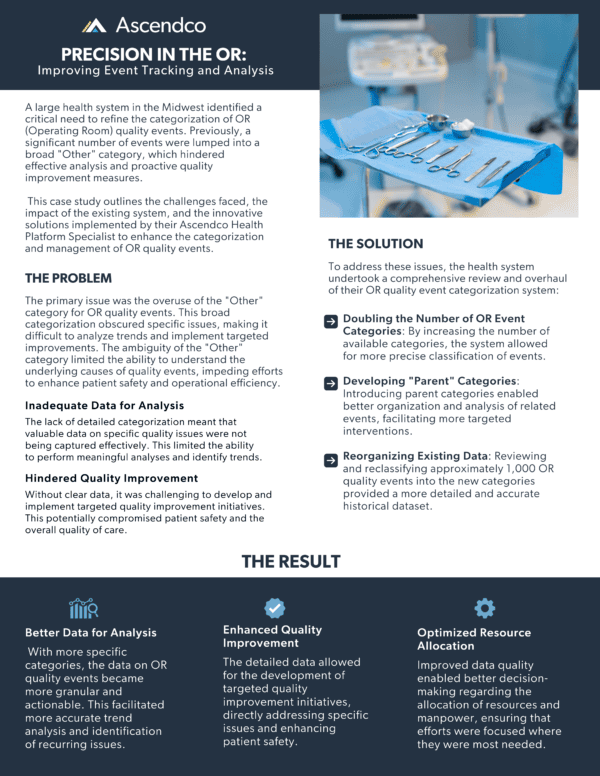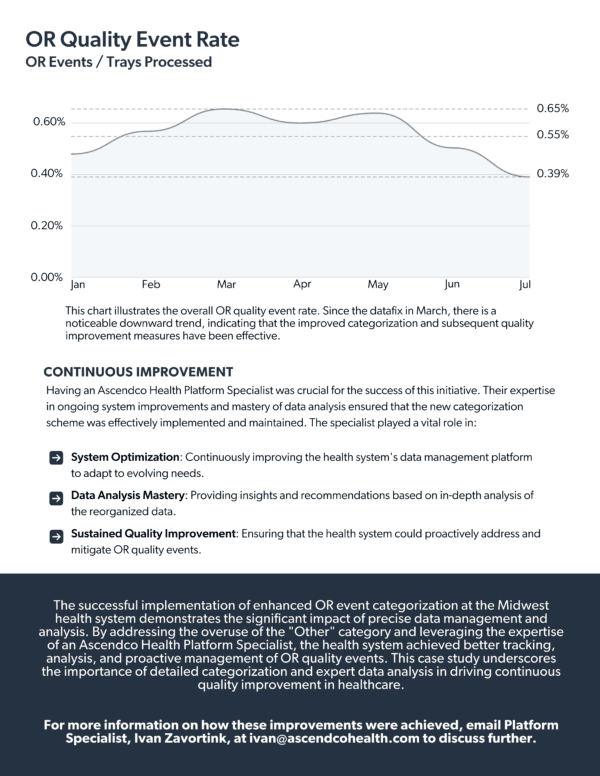Introduction
A large health system in the Midwest identified a critical need to refine the categorization of OR (Operating Room) quality events. Previously, a significant number of events were lumped into a broad “Other” category, which hindered effective analysis and proactive quality improvement measures. This case study outlines the challenges faced, the impact of the existing system, and the innovative solutions implemented to enhance the categorization and management of OR quality events.
The Challenge: Over-reliance on the “Other” Category
The primary issue was the overuse of the “Other” category for OR quality events. This broad classification limited the health system’s ability to accurately track, analyze, and address specific types of incidents. As a result, identifying trends and implementing targeted interventions became a significant challenge.
The Impact: Impaired Quality Improvement Efforts
The over-reliance on the “Other” category led to several negative consequences:
- Inefficient Data Analysis: With many events categorized under “Other,” it became difficult to perform detailed analysis and identify specific areas for improvement.
- Missed Trends: Important trends in OR quality events were obscured, preventing the implementation of targeted corrective actions.
- Limited Proactive Measures: Without clear categorization, it was challenging to develop proactive measures to prevent recurring issues.
The Solution: Enhanced Categorization and Analysis
To address these challenges, the health system implemented a comprehensive plan involving the expertise of an Ascendco Health Platform Specialist. The solution included:
- Doubling the Number of OR Event Categories: By increasing the number of available categories, the system allowed for more precise classification of events.
- Developing “Parent” Categories: Introducing parent categories enabled better organization and analysis of related events, facilitating more targeted interventions.
- Reorganizing Existing Data: Reviewing and reclassifying approximately 1,000 OR quality events into the new categories provided a more detailed and accurate historical dataset.
Visual Data Analysis
The following charts illustrate the impact of the implemented changes:
- OR Quality Event Rate
- The OR Quality Event Rate chart shows a noticeable decline in event rates following the data reorganization in March, indicating the positive impact of the enhanced categorization.
Importance of an Ascendco Health Platform Specialist
Having an Ascendco Health Platform Specialist was crucial for the success of this initiative. Their expertise in ongoing system improvements and mastery of data analysis ensured that the new categorization scheme was effectively implemented and maintained. The specialist played a vital role in:
- System Optimization: Continuously improving the health system’s data management platform to adapt to evolving needs.
- Data Analysis Mastery: Providing insights and recommendations based on in-depth analysis of the reorganized data.
- Sustained Quality Improvement: Ensuring that the health system could proactively address and mitigate OR quality events.
Conclusion
The successful implementation of enhanced OR event categorization at the Midwest health system demonstrates the significant impact of precise data management and analysis. By addressing the overuse of the “Other” category and leveraging the expertise of an Ascendco Health Platform Specialist, the health system achieved better tracking, analysis, and proactive management of OR quality events. This case study underscores the importance of detailed categorization and expert data analysis in driving continuous quality improvement in healthcare.
For more information on how these improvements were achieved, email Ivan Zavortink at ivan@ascendcohealth.com to discuss further.


